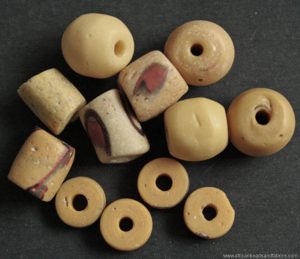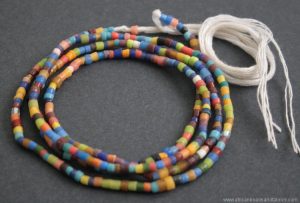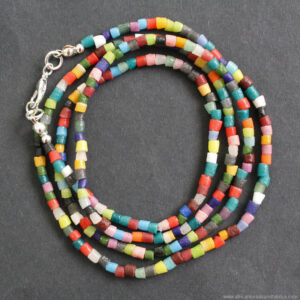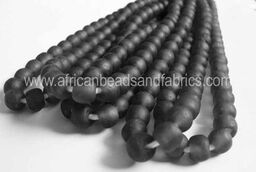Introduction
Traditional glass beads made in Ghana are often referred to as “Krobo” beads because they are predominantly made in the Krobo area in the Eastern Region of Ghana.
History
Beads have been made in Ghana for many centuries. In the past they were made of various materials including stone, bone, wood, coconut shells, sea shells, clay and brass. Archeological evidence suggests that stone, bone and ceramic beads have been used in the area for thousands of years.
Before the arrival of Europeans in West Africa, stone beads were produced in Ghana. Various ethnic groups used raw or natural materials available in their locality to manufacture beads.
Contact with traders from across the Sahara Desert and Europeans from across the ocean introduced new materials for bead making in the area.
Glass bead-making is thought to have been introduced to the Krobos by Europeans. Around the 16th century glass bead production sprung up in different parts of Europe to satisfy the African market including Bohemia (Czech beads), Holland and Italy (Venetian beads).
These beads are referred to as “trade beads” as they were a form of currency for purchasing goods in West Africa. Unfortunately, there is a sinister association between use of these beads and the Trans-Atlantic slave trade.
- yellow Trade Beads were especially popular
- an assortment of old beads
- Millefiori Trade beads
The production and use of trade beads have since then become prominent in the culture of the Krobo people. Trade beads production has undergone a complete evolution over time with the current products being made mainly from broken glass.
Cultural Perspective
Traditionally beads have been considered a status symbol representing wealth and financial success. It has been used by royalty to portray their wealth.
They are also used as accessories by dancers in traditional gatherings. Flag bearers of the traditional Asafo militia of the Fante people wear beads made of cowries across their chest during traditional parades at festivals.
In Ewe culture people recovering from a serious illness wear green beads as a sign of new life.
Red beads are worn at times of mourning. Bauxite beads are also used during funerals. Beads are used to adorn the deceased during funerals.
Waist beads have been worn by women as a piece of intimate adornment. They are worn under their clothing where they can only be seen by their husbands as one would wear a special set of lingerie. In recent years use of waist beads have become fashionable especially among Africans in the Diaspora.
- traditional waist beads are secured by cotton cord
- modern waist beads with clasp
- imported waist beads on tie cord
Many new mothers in Ghana wear white beads as a sign of victory after childbirth, a testament to previous high levels of maternal mortality. Survival after childbirth is a time of celebration.
Babies have beads placed around their waists and wrists ostensibly to ward off evil spirits. The practice is however a means of monitoring child growth and nutritional status. Thus, when the beads around the waist of the child slips over the buttocks, the parents are alerted of the child’s loss of weight and a possible onset of malnutrition.
Puberty is a time of extensive use of beads. The Dipo initiation ceremony of the Krobo people is a time where adolescent girls are decorated with beads.
During traditional marriage ceremonies beads are used as adornment for the couple and also as part of the dowry.
In the olden days, accumulation of valuable beads as one went through life served as an ancient form of “pension pot” which could be sold off in the future at times of financial crises. Ancient trade beads constitute family heirlooms which are passed on from generation to generation and continue to command high prices even to this day.
Examples of recycled glass beads available in our stores:
- powder glass cuboid beads










